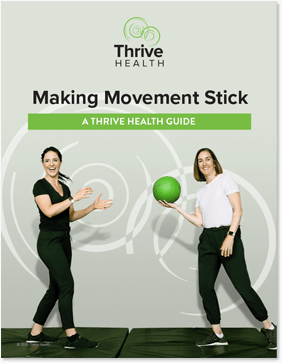Thrive Health provides evidence-based exercise resources for cancer survivors & expert training for fitness and health professionals.
A FORMULA FOR FITNESS
Written by Thrive Team

Wouldn’t it be great if there was a formula for active living? A guide you could use as a framework to get started, or as a check-in to see if you’re on the right track.
Well, you are in luck! The World Health Organization (WHO) and the Canadian Society for Exercise Physiology provide evidence-based exercise guidelines that support key health benefits, including weight management, chronic disease prevention and management, maintenance of muscle mass, improvement in mental health, and many more.
When we look at these guidelines, there is one key message that stands out àlimit your sedentary time! In other words, choose to take the stairs instead of the elevator, choose to walk instead of drive, choose to head outside for a hike with the family instead of parking yourself in front of the T.V.
In addition to limiting sedentary time, the World Health Organization and Canadian Society for Exercise Physiology recommend the following as activity guidelines for each week:
- +150 minutes of moderate-intensity, or 75 minutes of vigorous-intensity aerobic activity. This is your cardiovascular-type exercise, which includes walking, hiking, swimming, running, or anything that gets your heart rate up for at least 10 minutes at a time.
- +Two or more days of muscle-strengthening. This is your strength training type exercise, which includes any exercise where you challenge your muscles against resistance. This can be using your own body weight (i.e. in a push-up) or using equipment like dumbbells or resistance bands.
- +Flexibility exercise most days of the week. This includes any activity where you spend time stretching your muscles. This is best to do when your muscles are warm, such as after a warm-up or after you have completed your aerobic exercise or strength training.
Keep in mind, guidelines are designed for the average person – someone who is not currently healing from an injury, or newly diagnosed with an acute or chronic illness. Depending on your exercise experience, current fitness level, your activity goals, current injuries, or health status, these guidelines would need to be modified.
Our suggestion here at Thrive Health is for our clients to spend one week tracking their current activity (this is something you can start today!). At the end of each day, take 2-minutes to write down what you did that day for activity. Write down how many minutes you spent on that activity and how difficult it was (check out the Borg Rated Perceived Exertion scale here: https://www.cdc.gov/physicalactivity/basics/measuring/exertion.htm). Did you walk to work? Bike with your children to school? Choose to have a walking meeting? Make time to go to the gym to do 30 minutes of strength training and stretching? Write it down. At the end of the week, add up how much aerobic, strength and flexibility activity you accumulated. Then compare your current activity with the guidelines listed above. This can give you an idea for where you are at and see where is there room for improvement. Because for most of us, there is room to “move more”.
Check back for future blogs where we will dive into the specifics of how to assess and plan for aerobic, strength and flexibility exercise that best fits your goals.
Interesting fact – did you know, these guidelines are the same for our cancer thrivers! The American Cancer Society and Canadian Cancer Society also recommend these exercise guidelines for individuals with cancer. Exercise is recommended as safe and beneficial during cancer treatment, and essential during cancer survivorship – and must be modified or tailored to fit cancer thrivers’ needs, goals and fitness levels.
Enjoy your wellness Wednesday, and let’s get tracking activity levels! How can you move more?

Get the facts
Sign up for free, evidence-based exercise oncology insights sent to your inbox once a month, and get instant access to our free guide, Making Movement Stick!
